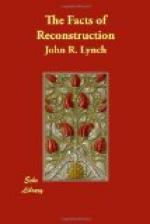It is a fact well known that the President was anxious to avoid a break with Senator Conkling. Judge W.H. Robertson, who was a candidate for the Collectorship of the port of New York was strongly supported by Mr. Blaine. Judge Robertson had been one of the influential leaders of the Blaine movement in New York. It was he who had disregarded the action of the State Convention in instructing the delegates to cast the vote of the State as a unit for General Grant. In bolting the action of the State Convention Judge Robertson carried about nineteen other delegates with him over to Mr. Blaine. Therefore Mr. Blaine insisted upon the appointment of Judge Robertson to the Collectorship of the port at New York. Senator Conkling would not consent under any circumstances to this appointment. Mr. Blaine, it appears, succeeded in convincing the President that, but for Judge Robertson’s action, his, Garfield’s, nomination would have been impossible and that consequently it would be base ingratitude not to appoint Robertson to the position for which he was an applicant. Mr. Blaine contended that the administration would not only be guilty of ingratitude should it refuse to appoint his candidate, but that it would thereby allow itself to be the medium through which this man was to be punished for his action in making the existence of the administration possible.
“Can you, Mr. President, afford to do such a thing as this?” asked Mr. Blaine.
To which the President gave a negative answer. Perhaps it did not occur to Mr. Blaine at that time that, while the action of Judge Robertson may have made the nomination of Mr. Garfield possible, the subsequent action of Senator Conkling made his election possible. But, notwithstanding this, the President decided that Judge Robertson should have the office for which he was an applicant.
As previously stated, however, the President was anxious to avoid a break with Senator Conkling. To get the Senator to consent to the appointment of Judge Robertson was the task the President had before him. With that end in view the President invited Mr. Conkling to a private conference, at which he expressed a willingness to allow the New York Senator to name every important Federal officer in New York except the Collector of the Port, if he would consent to the appointment of Judge Robertson to that office. But the only concession Senator Conkling was willing to make was to give his consent to the appointment of Judge Robertson to any position in the foreign service. This was not satisfactory, hence the conference was a failure. The President was thus placed in a very disagreeable dilemma, being thus forced, very much against his inclination, to take a decided stand in a very unpleasant controversy. He was thus forced to choose between Mr. Blaine, his own Secretary of State, on one side, and Senator Conkling on the other. To one he felt that he was indebted for his nomination. To the other he believed that his election was largely




